SEO Cheat Sheet
Sometimes, it’s hard to know what else can be done to boost traffic and rank. Especially when you feel like you’ve tried everything! Here are some suggestions – an SEO cheat sheet comprised of tips and tricks that I use on a daily basis to help my clients’ businesses.
I always start by looking at my data through these lenses: impressions, click through rates and keyword ranking. In a recent post, I described how to find low-hanging fruit in SEO by identifying pages that are hovering around success, but need a little push. Check out that post for details about how to find impressions, click through, and rank data about pages that are ripe for improvement using Google Search Console data.
Once you’ve found a page you want to optimize, select a tactic below that best matches that page’s situation.
Improve the Page’s Metadata
Page title and meta description are what we call “on-page” SEO, as they are short lines of HTML that are added to the page code to inform search engine crawlers about the content and intended search matching of the page. Additionally, page title and meta description are usually used to populate the text of organic results.
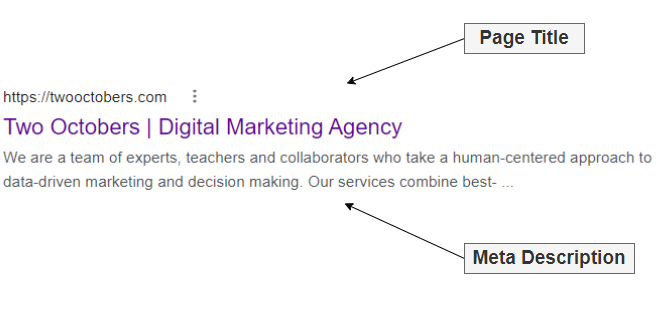
- Does the title and description match the user’s (& Google’s) search intent?
- Improve click through rate by improving what people see about the page on the search engine results page:
| Metadata Guide | |||
|---|---|---|---|
| Character Limit | Best Practices | ||
| Page Title | 60 Characters (Including Spaces) | Include primary keyword (and secondary, if possible) | |
| Meta Description | 155 characters (Including spaces) | Include primary keyword (and secondary if possible) Include a call to action ("Browse our inventory today!") | |
If you’re lucky enough to be using Branch Explorer, please refer to the Topic Explorer page.
The Topic Explorer page can drill down into metrics surrounding specific topics to give greater visibility for the highest volume keywords and modifiers.
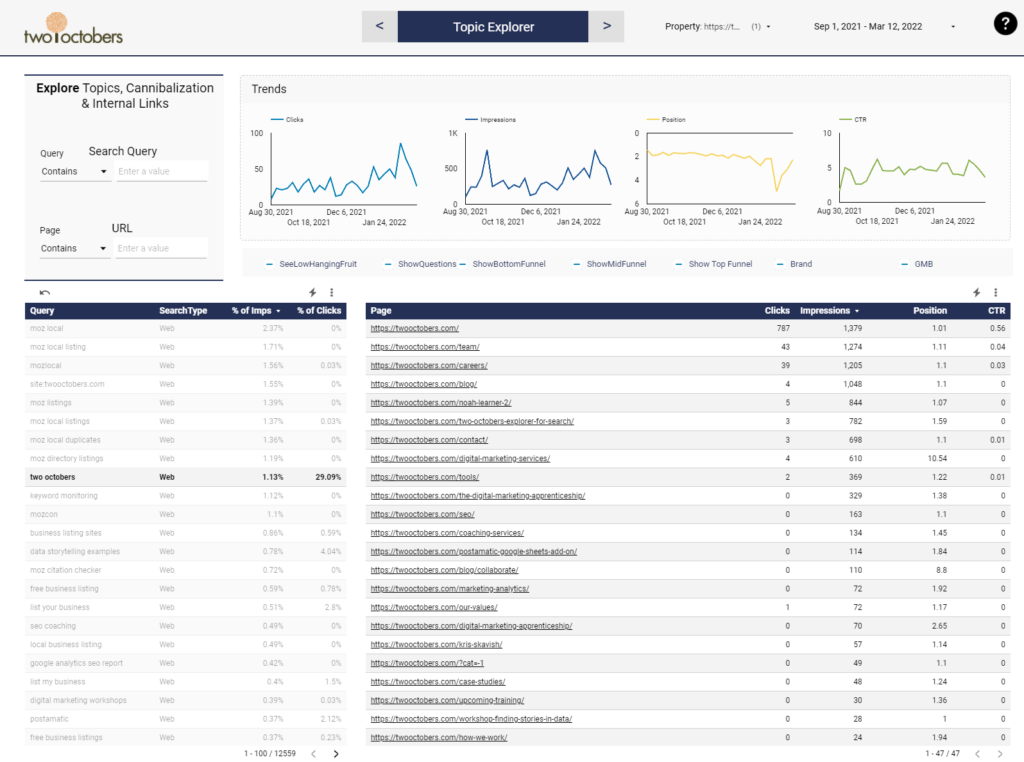
The screenshot shows the Topic Explorer page of the TO Explorer, which contains graphs, date range control, and filters for the following to give you maximum visibility into optimization of on-page SEO signals like page title and meta description;
- Keywords
- URLs
- Low Hanging Fruit
- Branded searches
- Question searches
- Funnel stage
The same type of filtering is available within GSC’s native data exports with Sheets or Excel, but ends up being significantly more difficult to achieve the layering of filters that TO Explorer includes as a standard. Formulas we would recommend include CountIf, AverageIf, and Query for parsing within Sheets or Excel.
Metadata Improvement Example
The typical checks that should be completed surrounding metadata are as follows;
- Are the title and description within the character limits?
- Are the title and description unique (not reused for multiple pages)?
- Do the title and description both include the primary keyword and modifier for the page?
- Is there a clear “next step” for users (a “Call to Action” or CTA)?
In the example used during the webinar, we audited a page for all 10 of these opportunities. In the case of the page we reviewed, the meta description was short, included the author names only, and lacked crucial information about the page content. In this case, we revised the meta description from;
“By Maggie Castle & Jaimee LaTorra”
to:
“Learn about data storytelling and Two Octobers’ 8 commandments for telling a story with data visualizations and examples. Make your data speak for itself!”
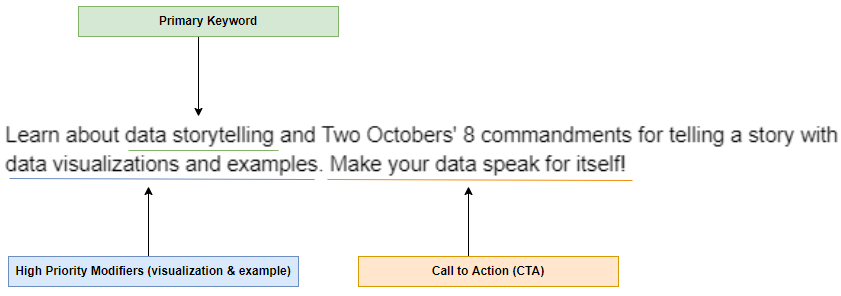
Enhance the Header Structure
Is the information clearly laid out and easy to understand?
- Headers communicate high-level content structure – think “Research Outline”
- Excellent place to leverage keywords
- Useful for HTML Table of Contents
- Helps users digest information
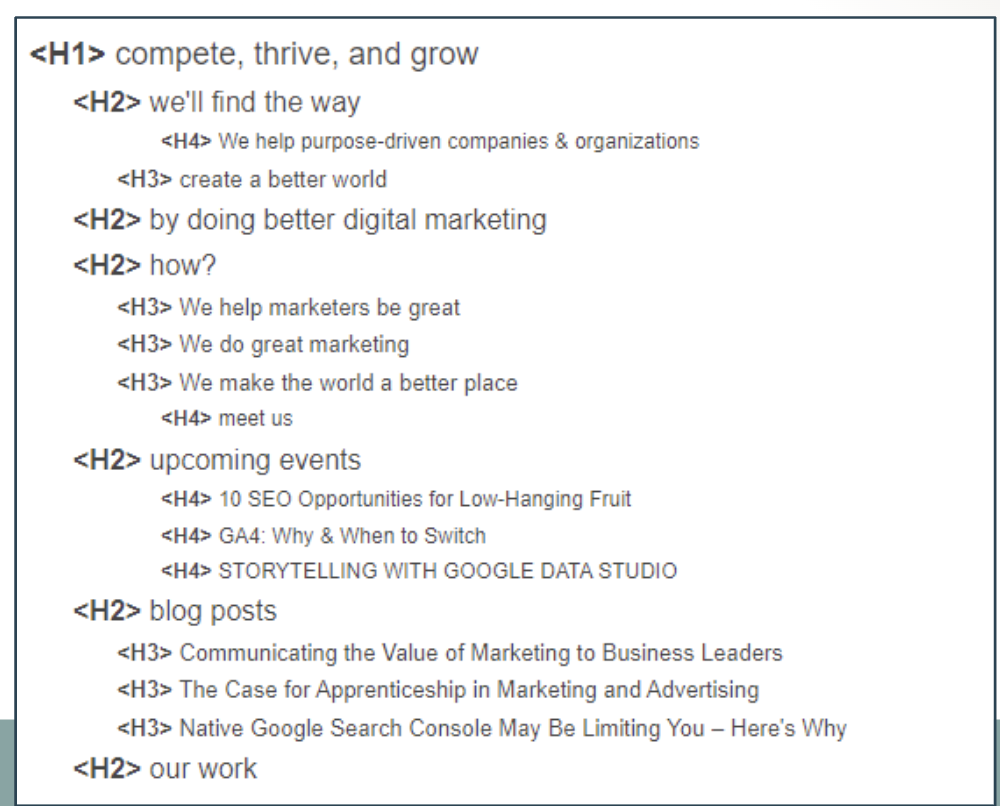
Tool Tip: Need a quick way to access this information?
Check out: Chrome Extension “SEO META in 1 CLICK”.
Review & Improve Links to the Page
Links are the basis of authority signals in Google’s index, as they indicate which pages on your site are most important to your business, and which pages are most important to internet users. Ask yourself :
- Does the page have enough internal links to indicate the value of the page?
- Is the page linked in the top navigation of the website?
- Is the page linked as a resource for further consideration?
- Is the page linked to other high value pages?
- Is the page link’s anchor text relevant and informative?
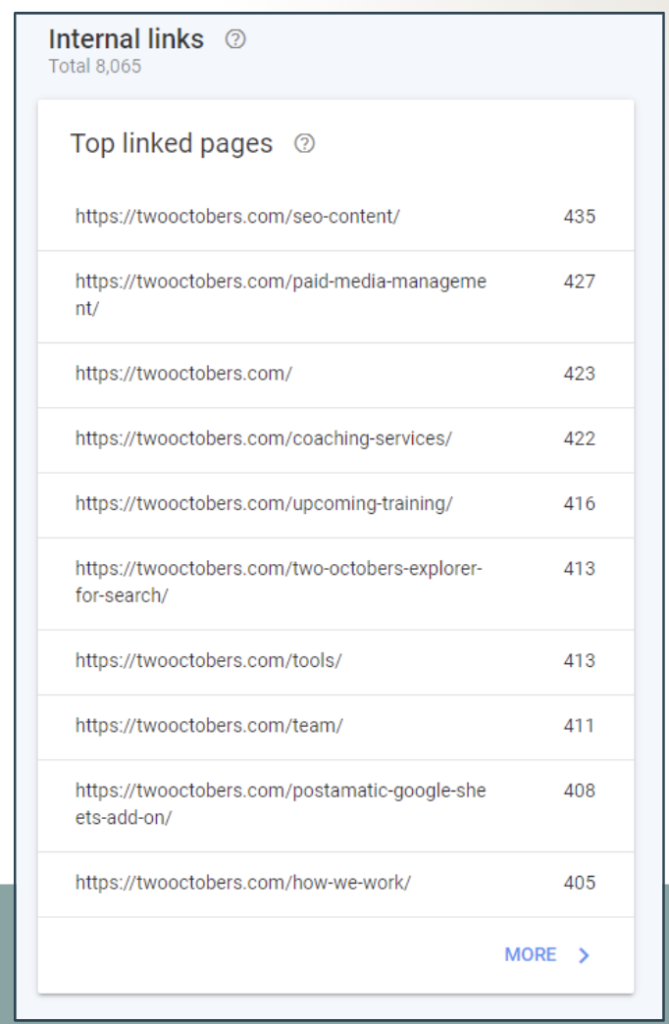
Tool tip: Google Search Console: “Links” tab
Complete a Competitive Audit
Search for your target keyword in Google, and audit the top listings to get a sense of what the competitive landscape looks like for given keywords.
- Do the top results on the search engine results page (SERP) include information about topics that yours does not?
- Topic Explorer in the TO Explorer can be immensely helpful here; once you have identified a new piece of information to add to the page (based on competitors’ pages), use the Topic Explorer page to identify keywords to target in your new content blocks.
- Are your pages missing JSON-LD schema markups?
- Have you included LocalBusiness, FAQ, ContactPage, Article, BlogPosting, Authors, Products, ProductCollection, or HowTo schema on the website? Are your markups implemented in JSON-LD syntax?
- Are your competitors’ mobile page experiences better than your website’s?
- Are there slow load times? Bad formatting? Do page elements collapse to one column in a way that still makes sense?
- Is their meta description markedly better than or different from yours?
- Due to the competitive nature of the search index rankings, differences between meta descriptions of the top ranked websites and your own website can show differences in search intent that your description may not capture.
Tool tip: This is best performed in Google search with manual reviews of competitors. Old school sometimes can be the best school.
Review Canonical Links
Is this page clearly marked as the ‘original’, or is it pointing elsewhere to a different ‘original’ page? Canonicals demarcate pages which are either:
- Originals
- Duplicates

Using canonical links is especially necessary for eComm stores with filtered pages. Original pages should be “self-referencing”.
Add Top Selling & Most Popular
Are your competitors providing popular products/services on their pages? Do your customers have clear “next steps” which direct them toward your desired conversions? Here are some examples of next steps you could encourage them to take by adding more content to existing pages:
- Products/Services
- Locations
- Blogs/Articles
- Testimonials
Review FAQs for Target Keywords
Are there any questions being searched in high volumes which aren’t bringing any traffic to the site? Keep in mind that FAQs are excellent drivers for keyword matching and keyword expansion. Make sure you take a look at these as a potential SEO opportunity to improve your rank.
Tool Tip: Use Explorer’s Question Searches page to go deeper into this area, and layer on filters to get an extremely granular drill down into keyword data.
Review Core Web Vitals Scores
Check your Core Web Vitals to make sure everything is working as it should.
Are there parsing or rendering issues which cause the content to take longer than 3 seconds to load? If there are, please dig into those because they are blocking your success.

Tool tip: Make sure to go to Google’s Page Speed Insights to check your vitals.
Schema Markup
Schema markup is a great way to help your website stand out from your SEO competitors.
It’s a form of microdata. Once added to a webpage, it will create an enhanced description (known as a rich snippet). It’s important because it is how a search engine interprets the context of a keyword. This is what determines the overall quality of a search result.
Schema markups provide pages with eligibility for Rich Results in Google’s results (People Also Ask, Featured Snippets, etc.). You’ll want to make sure this is optimized. Here’s how:
- Place schema intentionally.
- Ensure that required attributes are included in the markup.
- Schema.org has information about required attributes for given markup types
- Google’s Rich Results tester can also be used to make sure the markup works prior to implementation on the page.
- Place on high-value pages with comprehensive information.
Location Information
Location pages and information provide Google (and other search engines) with information for “near me” searches. Here’s how you can go about optimizing for location.
- If only one location, utilizing a “contact” page can work
- Businesses with multiple locations should have a page for each location, and highlight their uniquenesses with customized text.
- Featuring the name, address, and phone number (NAP) on your website provides a citation which reinforces Google Business Page (formerly Google My Business) listings.
I hope these SEO opportunities will help you fight the good fight to improve rank in Google and other search engines, ultimately driving more traffic to your website.
Questions, Comments, Or Concerns?
At Two Octobers, we love receiving feedback about our tools, processes, and work. If you have further questions, reach out to us! Feedback about ways in which a tool could be improved? Reach out to us! Comments about ways in which our tools or work have impacted your business? Reach out to us!




